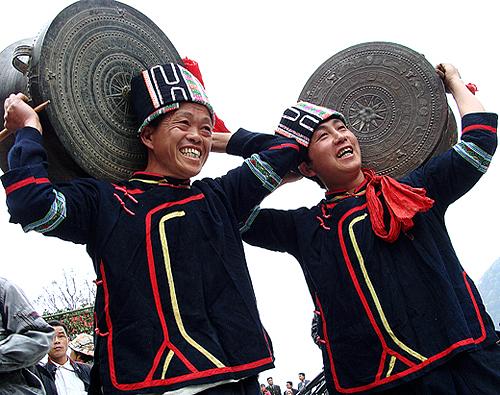Bronze drum research requires multidisciplinary cooperation

Bronze drums have played a crucial role in the history of many ethnic groups in southern China. The beautiful design and sound of bronze drums have enriched the cultures of these groups.
China has a long history of using bronze drums. It has the largest quantity of preserved drums and more historical documents related to these artifacts than anywhere else. Many ancient Chinese books include records about bronze drums. The History of the Later Han Dynasty contains a story about a bronze drum. During the reign of Emperor Qianlong (1711-99) in the Qing Dynasty (1616-1911), Liang Shizheng (1697-1763), a Qing court minister, was the first to collect drawings about bronze drums, which he turned into an encyclopedia. His encyclopedia launched ancient research into bronze drums.
But modern studies on bronze drums began in earnest after the influence of capitalism reached China. During this period, studies on bronze drums focused on the drums themselves and their places of origin. In 1884, German scholar Adolf Meyer published the book East Indies Antiquity in Leipzig, which set a precedent for studying bronze drums in Europe. Austrian scholar Frantz Hegel published the landmark book Southeast Old Metal Drums in 1902.
After World War I, Vietnam, another country which is famous for bronze drums, became significant in terms of bronze drum studies. During French colonial rule, the Institute of Far Eastern Natural Science was established in Hanoi and it gradually grew into a base for global research on bronze drums. Although scholars have located certain evidence to prove ethnic groups in southern China used bronze drums earlier than their counterparts in Vietnam, there has been no final conclusion on which country is the birthplace of bronze drums. After World War II, Western research on bronze drums declined and few professional scholars in this field emerged.
After the 1950s, studies on bronze drums became the focus of fierce debate between China and Vietnam. Wen You (1901-85), a professor of the Department of Chinese at Sichuan University, published Ancient Bronze Drum Catalogue in 1954. The Yunnan Provincial Museum published its collections of materials of bronze drums for the public. Chinese scholars utilized new archeological materials to probe into the various categories of bronze drums, the implications of ornamental elements, and the social functions of these drums, and successively published papers. In 1980, a seminar on ancient bronze drums was held in Nanning, which represented a new wave of research in China. China’s Research Society of Ancient Bronze Drums was set up at the seminar.
At the same time, Vietnamese scholars began to express their ideas about bronze drums in publications. In the 1970s, studies on bronze drums became a significant topic in the fields of Vietnamese archaeology and history. Perhaps the most notable opinion was that Dongson bronze drums are the earliest and most beautiful bronze drums, and are mostly distributed in Vietnam. So they concluded that northern Vietnam is the birthplace of bronze drums.
The origins of bronze drums are still unknown and this mystery needs to be solved. The development of studies into bronze drums is closely related to both social economic development and scientific progress. These studies will need to rely on archeological techniques and multiple disciplines.
Issues relating to bronze drums have permeated into many aspects of ancient minorities’ politics, economics and culture in southern China and Southeast Asia.
Since the 1980s, many scholars who have conducted natural science and technical science experiments have studied bronze drums. They contributed their wisdom to discovering aspects of bronze drums and their casting techniques and eliminated other obstacles that used to trouble bronze drum experts.
The joint partnership between archaeology and natural sciences will open a window for studies of bronze drums.
Wu Yong is a reporter at the Chinese Social Sciences Today.
